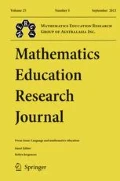Abstract
This study was designed to investigate the effects of an instructional intervention derived from the Garofalo and Lester (1985) cognitive-metacognitive framework on the problem-solving performance of Year 6 students with different ability levels. A quasi-experimental design was employed using one experimental and two control classes. Four different techniques were applied to identify above average, average, and below average students. There was a significant improvement in problem-solving performance for the experimental class compared with both control classes. Furthermore, higher ability students appeared to gain more from the experimental instruction than lower ability students. Implications for instruction and research are explored.
Similar content being viewed by others
References
Adibnia, A. (1996).An exploration of the effects.of a teaching method on year 6 students with different ability levels in mathematical problem solving based on Garofalo and Lester’s cognitive-metacognitive framework. Unpublished doctoral thesis, James Cook University.
Australian Council for Educational Research. (1978).Mathematics profile series: Space test [Test booklet]. Melbourne: Author.
Blackshear, P. B. (1979). A comparison of peer nomination and teacher nomination in the identification of the academically gifted, black, primary level students.Dissertation Abstracts International, 40, 2525A. (University Microfilm No. 79-25739)
Carss, M., & Osborne, A. (1982). The role of problem solving in school mathematics: A position paper of the Australian mathematics education program. In M. Carss & A. Osborne (Eds.),Applying problem solving: Readings in mathematics curriculum and instruction for Australian schools (pp. 52–57). Canberra: Curriculum Development Centre.
Charles, R., Mason, R. P., & Garner, D. (1985).Problem-solving experiences in mathematics: Teacher sourcebook. Menlo Park, CA: Addison-Wesley.
Charles, R., & Lester, F. K. (1982).Teaching problem solving: What, why, & how. Palo Alto, CA: Dale Seymour Publications.
Charles, R., Lester, F. K., & O’Daffer, P. (1992).How to evaluate progress in problem solving. Reston, VA: National Council of Teachers of Mathematics.
Cohen, L., & Manion, L. (1994).Research methods in education (4th ed.). London: Routledge.
Collis, K. F., & Romberg, T. A. (1992).Collis-Romberg mathematical problem-solving profiles. Melbourne: Australian Council for Educational Research.
DeRidder, C. M. (1987).A study of selected factors to identify sixth grade students gifted in mathematics. (Doctoral dissertation, University of Tennessee, 1987).Dissertation Abstracts International, 47, 4009A.
Ernest, P. (1989).Mathematics teaching: The state of the art. Borcombe, England: Falmer.
Flavell, J. H. (1979). Metacognition and cognitive monitoring: A new area of cognitive-development inquiry.American Psychologist, 34, 906–911.
Garofalo, J., & Lester, F. K. (1985). Metacognition, cognitive monitoring, and mathematical performance.Journal for Research in Mathematics Education, 16, 163–176.
Good, T. L., & Biddle, B. J. (1988). Research and the improvement of mathematics instruction: The need for observational resources. In D. A. Grouws, T. J. Cooney, & D. Jones (Eds.),Perspectives on research on effective mathematics teaching (pp. 114–142). Reston, VA: National Council of Teachers of Mathematics.
Grouws, D. A. (1985). The teacher and classroom instruction: Neglected themes in problem solving research. In E. A. Silver (Ed.),Teaching and learning mathematical problem solving: Multiple research perspectives (pp. 295–308). Hillsdale, NJ: Lawrence Erlbaum.
Jeffery, P. (1990). Constructivism, autonomy and mathematics education. In K. Milton & H. McCann (Eds.),Mathematical turning points: Strategies for the 1990’s (Proceedings of the 13th biennial conference of the Australian Association of Mathematics Teachers, Vol. 2, pp. 344–347). Hobart: AAMT.
Johnson, D. A., & Rising, G. R. (1972).Guidelines for teaching mathematics (2nd ed.). Belmont, CA: Wads worth.
Kroll, D. L., & Miller, T. (1993). Insights from research on mathematics problem solving in the middle grades. In D. T. Owens (Ed.),Research ideas for the classroom: Middle grade mathematics (pp. 58–77). New York: Macmillan.
Landvogt, J. (1991).Teaching gifted children, developing programs for schools. Melbourne: Education Impressions.
Lester, F. K., Garofalo, J., & Kroll, D. L. (1989).The role of metacognition in mathematical problem solving: Final Report. (ERIC Document Reproduction Service No. ED 314 255)
Lester, F. K. (1994). Musing about mathematical problem solving research: 1970–1994.Journal for Research in Mathematics Education, 25, 660–675.
Luria, A. R. (1973).The working brain: An introduction to neuropsychology. New York: Basic Books.
McLeod, D. B., & Adams, V. M. (Eds.). (1989).Affect and mathematical problem solving: A new perspective. New York, NY: Springer-Verlag
National Council of Teachers of Mathematics. (1989).Curriculum and evaluation standards for school mathematics. Reston, VA: Author.
National Council of Teachers of Mathematics. (1991).Professional standards for teaching mathematics. Reston, VA: Author.
Owens, D. T. (Ed.). (1993).Research ideas for the classroom: Middle grade mathematics. New York: Macmillan.
Polya, G. (1945).How to solve it? Princeton, NJ: Princeton University Press.
Renzulli, J. S., & Smith, L H. (1980, November/December). An alternative approach to identifying and programming for gifted and talented students.Gifted Child Today, 4–11.
Scheffé, H. (1953). A method for judging all the contrasts in the analysis of variance.Biometrika, 40, 87–104.
Schoenfeld, A. H. (1983). Episodes and executive decisions in mathematical problem solving. In R. Lesh & M. Landau (Eds.),Acquisition of mathematics concepts and processes (pp. 345–395). New York: Academic Press.
Schoenfeld, A. H. (1987).Cognitive science and mathematics education. Hillsdale, NJ: Lawrence Erlbaum.
Schoenfeld, A. H. (1992). Learning to think mathematically: Problem solving, metacognition, and sense making in mathematics. In D. A. Grouws (Ed.),Handbook of research on mathematics teaching and learning (pp. 334–370). New York: Macmillan.
Silver, E. A. (1985). Research on teaching mathematical problem solving: Some underrepresented themes and needed directions. In E. A. Silver (Ed.),Teaching and learning mathematical problem solving: Multiple research perspectives (pp. 247–266). Hillsdale NJ: Lawrence Erlbaum.
Sowell, E. J., Zeigler, A. J., Bergwall, L., & Cartwright, R. M. (1990). Identification and description of mathematically gifted students: A review of empirical research.Gifted Child Quarterly, 34, 147–154.
Stillman, G. A. (1993).Metacognition and mathematical learning: A problem solving application. Unpublished master’s dissertation, University of Queensland.
Trafton, P. (1981). Overview: Providing for mathematically able students.Arithmetic Teacher, 28(6), 12–13.
Author information
Authors and Affiliations
Additional information
This article is based on the first author’s doctoral dissertation (Adibnia, 1996), which was completed under the direction of the second author.
Rights and permissions
About this article
Cite this article
Adibnia, A., Putt, I.J. Teaching problem solving to year 6 students: A new approach. Math Ed Res J 10, 42–58 (1998). https://doi.org/10.1007/BF03217057
Issue Date:
DOI: https://doi.org/10.1007/BF03217057




